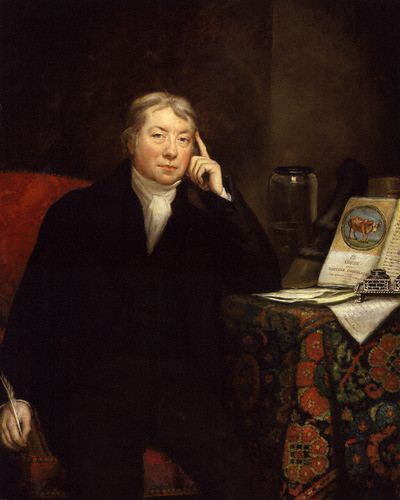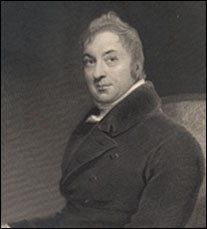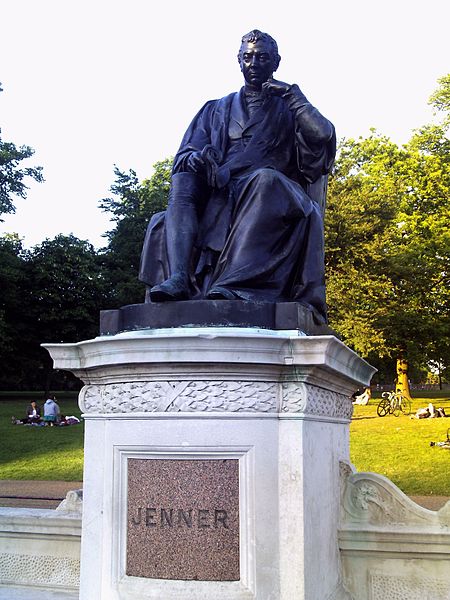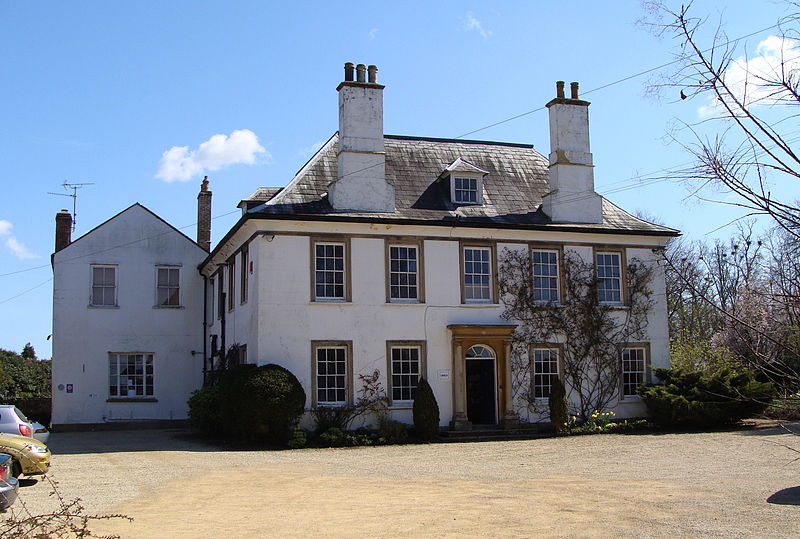<Back to Index>
- Microbiologist Edward Anthony Jenner, 1749
PAGE SPONSOR



Edward Anthony Jenner (17 May 1749 – 26 January 1823) was an English scientist who studied his natural surroundings in Berkeley, Gloucestershire. Jenner is widely credited as the pioneer of smallpox vaccine, and is sometimes referred to as the "Father of Immunology"; his works have been said to have "saved more lives than the work of any other man".
Edward Jenner was born on 17 May 1749 (6 May Old Style) in Berkeley, as the eighth of nine children. His father was the vicar of Berkeley and so Jenner received a strong basic education. Jenner trained in Chipping Sodbury, South Gloucestershire, as an apprentice to Daniel Ludlow, a surgeon, for eight years from the age of 13. In 1770 Jenner went up to surgery and anatomy under the surgeon John Hunter and others at St George's Hospital.
William Osler records that Jenner was a student to whom Hunter repeated William Harvey's advice, very famous in medical circles (and characteristically Enlightenment), "Don't think, try". Hunter remained in correspondence with him over natural history and proposed him for the Royal Society. Returning to his native countryside by 1773 he became a successful general practitioner and surgeon, practicing in purpose built premises at Berkeley.
Jenner and others formed a medical society in Rodborough, Gloucestershire, meeting to read papers on medical subjects and dine together. Jenner contributed papers on angina. This was the Fleece Medical Society or Gloucestershire Medical Society, so called as it met in the parlor of the Fleece Inn, Rodborough.
Lady Mary Wortley Montagu witnessed the Ottoman Empire practice of variolation during her 1716 - 1718 sojourn in Istanbul, where her husband was the British ambassador. She brought the idea back to Britain. Voltaire, a few years later, recorded that 60% of people caught smallpox, with 20% of the population dying of it.
In 1765 a Dr Fewster published a paper in the London Medical Society entitled "Cow pox and its ability to prevent smallpox" but did not pursue it further.
In
the years following 1770 there were at least six people in England and
Germany (Sevel, Jensen, Jesty 1774, Rendell, Plett 1791) who had
successfully tested the possibility of using the cowpox vaccine as an
immunization for smallpox in humans. For example, Dorset farmer Benjamin Jesty had successfully vaccinated and presumably induced immunity in
his wife and two children with cowpox during a smallpox epidemic in
1774, but it was not until Jenner's work some twenty years later that
the procedure became widely understood. Indeed, Jenner may have been
aware of Jesty's procedures and success.
Noting the common observation that milkmaids did not generally get smallpox, Jenner theorized that the pus in the blisters which milkmaids received from cowpox (a disease similar to smallpox, but much less virulent) protected the milkmaids from smallpox. He may have had the advantage of hearing stories of Benjamin Jesty and others who deliberately arranged cowpox infection of their families, and then noticed a reduced smallpox risk in those families.
On 14 May 1796, Jenner tested his hypothesis by inoculating James Phipps, a young boy of 8 years (the son of Jenner's gardener), with material from the cowpox blisters of the hand of Sarah Nelmes, a milkmaid who had caught cowpox from a cow called Blossom, whose hide hangs on the wall of the library at St George's medical school (now in Tooting). Blossom's hide commemorates one of the school's most renowned alumni. Phipps was the 17th case described in Jenner's first paper on vaccination.
Jenner
inoculated Phipps with cowpox pus in both arms on the same day. The
inoculation was accomplished by scraping the pus from Nelmes' blisters
onto a piece of wood then transferring this to Phipps' arms. This
produced a fever and some uneasiness but no great illness. Later, he
injected Phipps with variolous material,
which would have been the routine attempt to produce immunity at that
time. No disease had followed. Jenner reported that later the boy was
again challenged with variolous material and again showed no sign of
infection.
Ronald Hopkins states: "Jenner's unique contribution was not that he inoculated a few persons with cowpox, but that he then proved they were immune to smallpox. Moreover, he demonstrated that the protective cowpox could be effectively inoculated from person to person, not just directly from cattle. In addition he tested his theory on a series of 23 subjects. This aspect of his research method increased the validity of his evidence.
He
continued his research and reported it to the Royal Society, who did
not publish the initial report. After improvement and further work, he
published a report of twenty - three cases. Some of his conclusions were
correct, and some erroneous – modern microbiological and
microscopic methods would make this easier to repeat. The medical
establishment, as cautious then as now, considered his findings for some
time before accepting them. Eventually vaccination was accepted, and in
1840 the British government banned variolation – the use of
smallpox itself – and provided vaccination – using
cowpox – free of charge. The success of his discovery soon began to
spread around Europe and as an example was used en masse in the Spanish Balmis Expedition, a three year mission to the Americas led by Dr Francisco Javier de Balmis with
the aim of giving thousands the smallpox vaccine. The expedition was
successful and Jenner wrote, "I don’t imagine the annals of history
furnish an example of philanthropy so noble, so extensive as this.”
Jenner's continuing work on vaccination prevented his continuing his ordinary medical practice. He was supported by his colleagues and the King in petitioning Parliament and was granted £10,000 for his work on vaccination. In 1806 he was granted another £20,000 for his continuing work in microbiology.
In 1803 in London he became involved with the Jennerian Institution, a society concerned with promoting vaccination to eradicate smallpox. In 1808, with government aid, this society became the National Vaccine Establishment. Jenner became a member of the Medical and Chirurgical Society on its foundation in 1805, and subsequently presented to them a number of papers. This is now the Royal Society of Medicine. In 1806, he was elected a foreign member of the Royal Swedish Academy of Sciences.
Returning to London in 1811 he observed a significant number of cases of smallpox after vaccination occurring. He found that in these cases the severity of the illness was notably diminished by the previous vaccination. In 1821 he was appointed Physician Extraordinary to King George IV, a considerable national honor, and was made Mayor of Berkeley and Justice of the Peace. He continued his interests in natural history. In 1823, the last year of his life, he presented his Observations on the Migration of Birds to the Royal Society.
Jenner was found in a state of apoplexy on
25 January 1823, with his right side paralyzed. He never fully
recovered, and eventually died of an apparent stroke (he had suffered a
previous stroke) on 26 January 1823, aged 73. He was survived by one son
and one daughter, his elder son having died of tuberculosis at the age
of 21.
On December 1, 1796, Dr. John Clinch, a medical missionary at Trinity, then the second largest settlement in Newfoundland, sent a letter to Jenner in Gloucestershire. Clinch asked for further information about using cowpox pustule matter as a vaccination against smallpox. Jenner had vaccinated his first subject only 6 months earlier. By June 1800, when Jenner published his famous pamphlet, An Inquiry into the Causes and Effects of the Variolae Vaccinae, describing his vaccination experiments on 23 subjects, Clinch probably had been vaccinating people in Newfoundland for a year or more.
Jenner and Clinch, both born in 1749, had been classmates at Reverend Dr. Washbourn’s school in Cirencester, Gloucestershire, before they went to London together to be pupils of the distinguished surgeon John Hunter. Jenner returned to his home area, but Clinch practiced 3 years in Dorset near Poole, the main shipping port for Newfoundland. In 1775 Clinch moved to Newfoundland to practice in Bonavista. After 8 years he moved to Trinity, where he also preached the Anglican sermons on Sundays. Jenner’s nephew, George Jenner, aiming for a similar church – medicine career, very likely began his medical apprenticeship under Clinch at Trinity in 1789
On July 15, 1800, a second shipment of vaccine from Edward Jenner reached Clinch; one of these two vaccine shipments, most likely the first, came via George Jenner, by then the Anglican minister at Harbour Grace, on the intervening peninsula between Trinity and St. John’s. By the first week of October 1800 Clinch had vaccinated additional people in the adjacent settlements of St. John’s and Portugal Cove, and by the end of 1801 he had vaccinated 700 people.
William
R. LeFanu’s definitive bibliography of Jenner credits Clinch with being
the first vaccinator in North America, before Benjamin Waterhouse, who
vaccinated his own sons in July 1800 and then popularized vaccination in
Boston. Sadly, exact dates for Clinch’s first vaccinations are
unavailable for conclusive proof of his priority. Clinch is honored by a
memorial plaque in Trinity.
In 1979, the World Health Organization declared smallpox an eradicated disease. This was the result of coordinated public health efforts by many people, but vaccination was an essential component. And although it was declared eradicated, some samples still remain in laboratories in Centers for Disease Control and Prevention (CDC) in Atlanta, Georgia, in the United States, and State Research Center of Virology and Biotechnology VECTOR in Koltsovo, Novosibirsk Oblast, Russia.
The importance of his work does not stop there. His vaccine also laid the groundwork for modern day discoveries in immunology, and the field he began may someday lead to cures for arthritis, AIDS, and many other diseases of the time.
2010
marks the 30th anniversary of the eradication of smallpox, and an
illustrated history of the eradication of smallpox, “Smallpox Zero” was
published with the support of sanofi pasteur and distributed during an
event organized on May 17, 2010 in Geneva by the World Health
Organization. "Smallpox
Zero" features, among other things, President Thomas Jefferson's letter
to Edward Jenner on the inside of the front cover.
